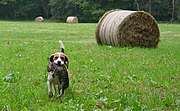Beagles were developed primarily for hunting hare, an activity known as beagling. They were seen as ideal hunting companions for the elderly who could follow on horseback without exerting themselves, for young hunters who could keep up with them on ponies, and for the poorer hunters who could not afford to maintain a stable of good hunting horses.[50] Before the advent of the fashion for foxhunting in the 19th century, hunting was an all day event where the enjoyment was derived from the chase rather than the kill. In this setting the tiny Beagle was well matched to the hare, as unlike Harriers they would not quickly finish the hunt, but because of their excellent scent-tracking skills and stamina they were almost guaranteed to eventually catch the hare. The Beagle packs would run closely together ("so close that they might be covered with a sheet"[9]) which was useful in a long hunt, as it prevented stray dogs from obscuring the trail. In thick undergrowth they were also preferred to spaniels when hunting pheasant.[51]
With the fashion for faster hunts, the Beagle fell out of favour for chasing hare, but was still employed for rabbit hunting. In Anecdotes of Dogs, Jesse says:
In rabbit-shooting, in gorse and thick cover, nothing can be more cheerful than the beagle; and they have been called rabbit-beagles from this employment, for which they are peculiarly qualified, especially those dogs which are somewhat wire-haired.[5]
In the United States they appear to have been employed chiefly for hunting rabbits from the earliest imports. Hunting hare with Beagles became popular again in Britain in the mid-19th century and continued until it was made illegal in Scotland by the Protection of Wild Mammals (Scotland) Act 2002 and in England and Wales by the Hunting Act 2004. Under this legislation Beagles may still pursue rabbits with the landowner's permission. Drag hunting is popular where hunting is no longer permitted or for those owners who do not wish to participate in blood sports but still wish to exercise their dog's innate skills.
The traditional foot pack consists of up to 70 Beagles, marshalled by a Huntsman who directs the pack and who is assisted by a variable number of whippers-in whose job is to return straying hounds to the pack. The Master of the Hunt is in overall day-to-day charge of the pack, and may or may not take on the role of Huntsman on the day of the hunt. Beagles may also be employed individually or in a brace (a pair).[52]
As hunting with Beagles was seen as ideal for young people, many of the British public schools traditionally maintained Beagle packs. Protests were lodged against Eton's use of Beagles for hunting as early as 1902 but the pack is still in existence today,[53] and a pack used by Imperial College in Wye, Kent was stolen by the Animal Liberation Front in 2001.[54] School and university packs are still maintained by Eton, Marlborough, Wye, Radley, the Royal Agricultural College and Christ Church, Oxford.[55]
Beagles have been used for hunting a wide range of game including Snowshoe Hare, Cottontail rabbits, game birds, Roe Deer, Red Deer, Bobcat, Coyote, Wild Boar and foxes, and have even been recorded as being used to hunt Stoat.[52][56] In most of these cases, the Beagle is employed as a gun dog, flushing game for hunter's guns.



 The Beagle has become a popular breed of dog in the United States over the past century or so. In fact, in the 1950’s, this breed enjoyed a brief stint at the number one spot for most sought after dogs in this country. But the Beagle’s roots go back much farther than 100 years or so – and could possibly date back to around 400 B.C. in Greece. Documents show that a Beagle type of dog may have been in existence at this time.
The Beagle has become a popular breed of dog in the United States over the past century or so. In fact, in the 1950’s, this breed enjoyed a brief stint at the number one spot for most sought after dogs in this country. But the Beagle’s roots go back much farther than 100 years or so – and could possibly date back to around 400 B.C. in Greece. Documents show that a Beagle type of dog may have been in existence at this time.



